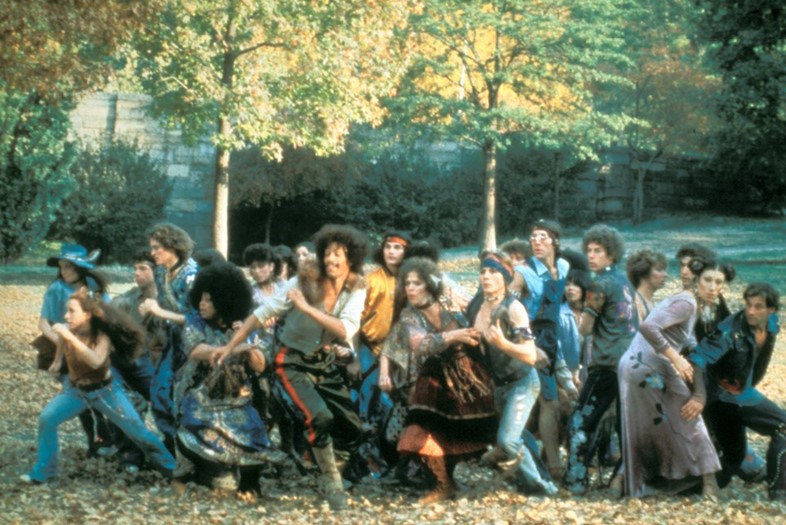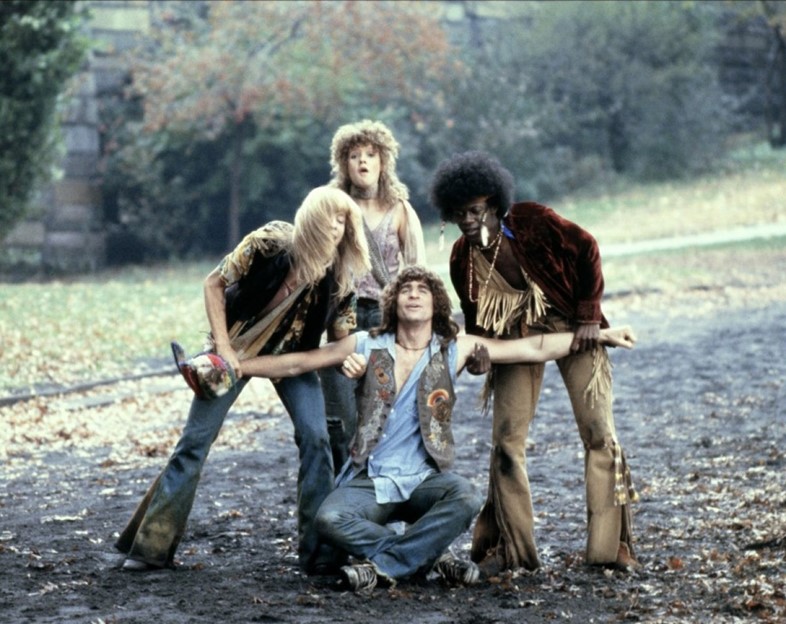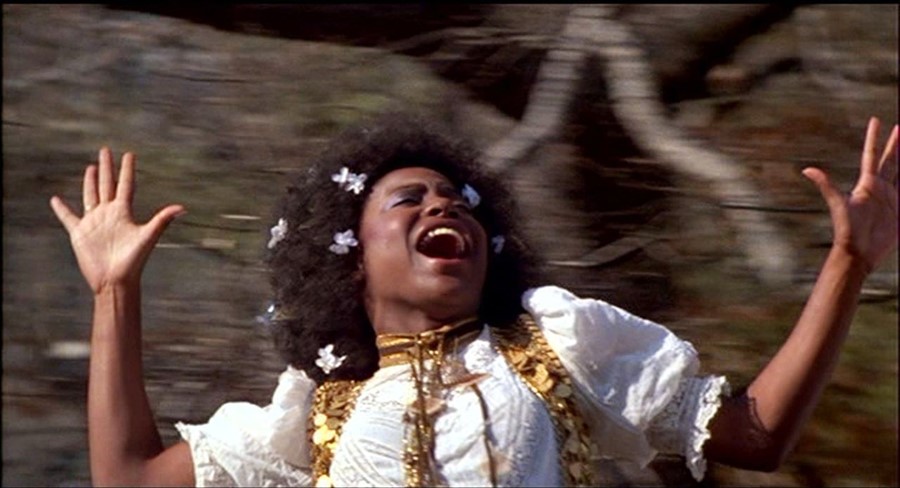As its musical counterpart celebrates its 48th birthday, we examine the political messages and abundant style tips present in the beloved 60s film, Hair
Racism, environmental destruction, poverty, war, gender equality… There was scarcely a controversial topic at play in late 1960s America that the musical production and film Hair didn't touch upon. Set predominantly in Central Park during Vietnam War-era New York, the story follows the induction of rural American rancher Claude Bukowski into a tribe of free-loving hippies, shortly before he joins the American army to be flown to Vietnam. More importantly, however, the story channeled all of the energy surrounding hippie counterculture directly into contemporary conversation. "There was so much excitement in the streets and the parks and the hippie areas, and we thought if we could transmit this excitement to the stage, it would be wonderful," authors James Rado and Gerome Ragni said of the moment. "We hung out with them and went to their be-ins and let our hair grow." This week marks the 48th anniversary of Hair’s opening on Broadway. To celebrate, we consider a few lessons we might learn from its rich and storied script.
1. Never underestimate the political power of hair
“Can you tell me why you’re so uptight about having your hair cut?” a suspicious prison guard asks Woof, when the gang are arrested for crashing a dinner party held by an aristocratic New York family, and violently refuse the clippers brandished at them on the way into prison. The protest prompts the magnificent musical outburst from which the film takes its name – just try to erase the rhythmic chant of “hair, flow it, show it, long as God can grow it” from your mind after watching the song – but it’s far from simply an aesthetically motivated decision. In an era when young men were being drafted en masse to fight in what many considered to be a purposeless war in Vietnam (“the draft is white people sending black people to make war on the yellow people to defend the land they stole from the red people!” a protesting hippie announces in one memorable moment) growing one’s hair was a stamp of pacifism, not to mention a powerful symbol of gender equality. “Hair was the hippies' flag,” theatre writer Scott Miller wrote of the show’s central motif, “their ... symbol not only of rebellion but also of new possibilities, a symbol of the rejection of discrimination and restrictive gender roles.”
From voluminous afros threaded with lilac flowers (“what have you done to your hair?” Hud’s strait-laced girlfriend asks when the pair are reunited, hammering home the political resonance of allowing black hair to exist in its natural state in the late 1960s) to the moment when uptight Sheila allows her tightly coiffed bouffant to fly freely in the breeze, as the group drive down to the army base to visit Claude, the film’s hairstyles inform and reflect the film’s political theme.

2. Don’t be afraid to make bold sartorial decisions
From the first moment when Oklahoma-born rancher Claude happens across the hippies dancing in Central Park, their clothing – colourful, threadbare, and comped together from feathers, flowers, beads and fringe – marks them out as free-thinking radicals amidst New York’s otherwise stuffy and conservative atmosphere. Little by little, as he spends more time with Berger and the gang, his own best suit becomes more and more bedraggled, until finally he departs for the army base and gives it up altogether for a uniform of khaki green, immediately becoming indistinguishable from the crowd.
Customisation is key here, the film teaches: add and take away until whatever you are wearing is entirely your own – and if you’re looking to channel the free-spirited Bohemia of Hair’s characters, the more tie-dyed cotton, free-flowing bell-sleeves and patch-adorned denim, the better.

3. Or, if you'd prefer, to wear no clothes at all
When Hair premiered at the Biltmore Theater on Broadway in April 1968, it was met with shock, horror and ecstatic disbelief, depending on where in the crowd one was sitting. Its political undercurrent, unmissable in its treatment of themes from the Vietnam war and illegal drugs, struck a chord with many, but its nude scene, though brief – the tribe walks onstage naked at the end of the first act, as Claude debates whether or not to burn his draft card – was perhaps the most notorious moment of all. Its inclusion was inspired by a moment in real life when the playwrights witnessed two men stripping naked at an anti-war demonstration in Central Park.
The powerful support of sexual freedom intrinsic in this flagrant display of real life nude bodies soon became synonymous with the musical, while songs such as the brilliantly named Sodomy – “Sodomy, fellatio, cunnilingus, pederasty, Father, why do these words sound so nasty?” the tribe sings. “Masturbation can be fun, join the holy orgy Kama Sutra everyone!” – support free love in the most explicit way imaginable. Indeed, so key was such controversy to its resonance that the opening night in London was delayed until the abolition of theatre censorship, precisely so that such a scene could be included. “Nudity was a big part of the hippie culture, both as a rejection of the sexual repression of their parents and also as a statement about naturalism, spirituality, honesty, openness, and freedom,” Miller writers. “The naked body was beautiful, something to be celebrated and appreciated, not scorned and hidden. They saw their bodies and their sexuality as gifts, not as 'dirty' things.”
4. When in doubt, turn to astrology
The power of Hair’s opening theme and guiding wisdom, Aquarius, is impossible to resist. “When the moon is in the seventh house and Jupiter aligns with Mars, then peace will guide the planets, and love will steer the stars.” The dawning of the age of Aquarius, that mystical moment which marks the beginning of a new astrological age and which many optimistic types believed occurred in the late 1960s, fundamentally altering the way the world worked, may be a fantastical notion, but it certainly is a reassuring one. As Claude soon learns, with a little help from psychedelics, everything happens for a reason. “Harmony and understanding, sympathy and trust abounding, no more falsehoods or derisions, golden living dreams of visions, mystic crystal revelation and the mind's true liberation.”
5. Use your right to protest
One of the most powerful symbols of all to emerge in Hair is that of the ‘be-in’ – a large-scale peaceful demonstration modelled on the first of its kind to take place in San Francisco’s Golden Gate Park in 1967, attended by more than 20,000 people. At the end of the film version, after the tragedy of timing which sees Berger drafted to Vietnam in Claude’s place, and which is followed by a heart-wrenching shot of the tribe singing around his gravestone shortly afterwards, the redeeming image of the USA’s hippies protesting in front of the White House is an empowering reminder of the triumph of love and peace in the face of evil – and a reminder that to protest is your right.
